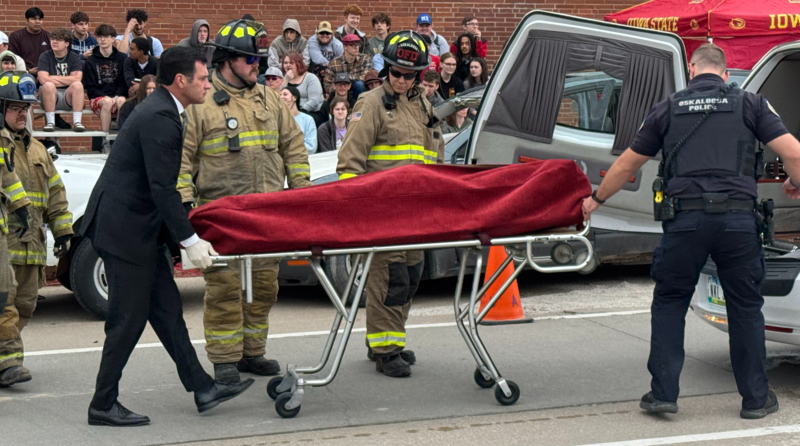Students Unite in Sobering Reminder About Choices Behind the Wheel
With a hearse slowly pulling up to the high school, silence fell over the crowd. It was a chilling moment of realism that capped weeks of student planning, culminating in a mock crash presentation designed to deliver a powerful message - distracted and impaired driving can, and does, kill. 
For seniors like Kelsie Hicks, taking part in the emotionally charged event wasn’t just an assignment, it was personal. As a Peer Helper, Hicks played a role in the simulated funeral and helped organize the sobering program, which aimed to show students the true cost of careless driving.
“It took a lot of thinking about feelings and putting ourselves in the shoes of if this really was to happen,” said Hicks. “You do cry because it’s like you’re imagining your friends dying.”
The crash simulation, which involved multiple local agencies and dozens of students, took more than a month to fully plan. From selecting participants to coordinating with emergency responders and community partners, every detail was carefully constructed to mimic a real tragedy.

Senior Sunny Netland portrayed the doctor who had to break the news to the fictional victim’s parents. Wearing scrubs, she embodied the harrowing moment many hope never to experience in real life.
“It took a couple of months,” Netland said. “We were emailing everybody, calling the hospital, the police department, printers, everybody. It was a huge deal.”
The scenario depicted a car accident involving distracted driving, and the students designed every element to feel authentic, from the mangled cars and medical response to the Unity Point Life Flight helicopter landing on-site and the funeral that followed. One of the final, most powerful touches was the arrival of a hearse, provided by Bates Funeral Chapel.

“Our goal is to bring an element of reality to what’s happening,” said Michael Sytsma of Bates Funeral Chapel. “The hearse pulling up is a dramatic part of the entire program. It’s not just an ambulance—it’s a vehicle everyone associates with someone passing away.”
Sytsma, who has participated in the event since 1998 when he was a student himself, said each year carries a unique emotional weight. Now he’s a parent of students in the district, the message hits even closer to home.

“Every year, I think it’s not going to be as impactful,” he said. “But every year it is. The students always find a way to change it just enough.”
The student team deliberately chose participants to deepen the emotional impact. The crash “victim,” portrayed by a student leader involved in many school activities, symbolized how tragedy can strike anyone, regardless of how promising their future may be.
“That really showed the community cared about her,” Netland said. “She would represent a good person who would die.”
For Hicks, the project connected to a near-tragedy close to her heart. Someone she knows was involved in a serious accident, believed to be caused by distracted driving.
“He could have died. He could have killed people,” she said. “This shows that it really can happen.”
Organizers said their goal wasn’t just to stage a dramatic scene. It was to leave a lasting impression that could save lives.

“I definitely saw some people get emotional,” Netland said. “I’m hoping this message stuck to most of them.”
The realism was no accident. It was the result of dedicated coordination, heartfelt storytelling, and support from local agencies. Students took ownership of every part, from scripting to acting to technical logistics.
Sytsma credited Carrie Bihn, the Oskaloosa High School Peer Helper advisor who helps lead the event, for keeping the program going each year. “I think it’s a great thing to send a message to the kids,” he said.
The message, while heartbreaking, is clear: Lives change in seconds. A glance at a phone, a drink before driving, a moment of carelessness can be fatal.
“It takes two seconds to look down at your phone, and you can kill yourself or somebody else,” Hicks said.With a hearse slowly pulling up to the high school, silence fell over the crowd. It was a chilling moment of realism that capped weeks of student planning, culminating in a mock crash presentation designed to deliver a powerful message - distracted and impaired driving can, and does, kill.
For seniors like Kelsie Hicks, taking part in the emotionally charged event wasn’t just an assignment, it was personal. As a Peer Helper, Hicks played a role in the simulated funeral and helped organize the sobering program, which aimed to show students the true cost of careless driving.
“It took a lot of thinking about feelings and putting ourselves in the shoes of if this really was to happen,” said Hicks. “You do cry because it’s like you’re imagining your friends dying.”
 The crash simulation, which involved multiple local agencies and dozens of students, took more than a month to fully plan. From selecting participants to coordinating with emergency responders and community partners, every detail was carefully constructed to mimic a real tragedy.
The crash simulation, which involved multiple local agencies and dozens of students, took more than a month to fully plan. From selecting participants to coordinating with emergency responders and community partners, every detail was carefully constructed to mimic a real tragedy.
Senior Sunny Netland portrayed the doctor who had to break the news to the fictional victim’s parents. Wearing scrubs, she embodied the harrowing moment many hope never to experience in real life.
“It took a couple of months,” Netland said. “We were emailing everybody, calling the hospital, the police department, printers, everybody. It was a huge deal.”
The scenario depicted a car accident involving distracted driving, and the students designed every element to feel authentic, from the mangled cars and medical response to the Unity Point Life Flight helicopter landing on-site and the funeral that followed. One of the final, most powerful touches was the arrival of a hearse, provided by Bates Funeral Chapel.
“Our goal is to bring an element of reality to what’s happening,” said Michael Sytsma of Bates Funeral Chapel. “The hearse pulling up is a dramatic part of the entire program. It’s not just an ambulance—it’s a vehicle everyone associates with someone passing away.”
Sytsma, who has participated in the event since 1998 when he was a student himself, said each year carries a unique emotional weight. Now he’s a parent of students in the district, the message hits even closer to home.

“Every year, I think it’s not going to be as impactful,” he said. “But every year it is. The students always find a way to change it just enough.”
The student team deliberately chose participants to deepen the emotional impact. The crash “victim,” portrayed by a student leader involved in many school activities, symbolized how tragedy can strike anyone, regardless of how promising their future may be.
“That really showed the community cared about her,” Netland said. “She would represent a good person who would die.”
For Hicks, the project connected to a near-tragedy close to her heart. Someone she knows was involved in a serious accident, believed to be caused by distracted driving.
“He could have died. He could have killed people,” she said. “This shows that it really can happen.”
Organizers said their goal wasn’t just to stage a dramatic scene. It was to leave a lasting impression that could save lives.
“I definitely saw some people get emotional,” Netland said. “I’m hoping this message stuck to most of them.”
The realism was no accident. It was the result of dedicated coordination, heartfelt storytelling, and support from local agencies. Students took ownership of every part, from scripting to acting to technical logistics.
Sytsma credited Carrie Bihn, the Oskaloosa High School Peer Helper advisor who helps lead the event, for keeping the program going each year. “I think it’s a great thing to send a message to the kids,” he said.
The message, while heartbreaking, is clear: Lives change in seconds. A glance at a phone, a drink before driving, a moment of carelessness can be fatal.
“It takes two seconds to look down at your phone, and you can kill yourself or somebody else,” Hicks said.
A medical helicopter lands at Oskaloosa High School during a mock crash simulation, bringing a chilling sense of urgency and realism to the distracted driving awareness event organized by student peer helpers and community first responders.

